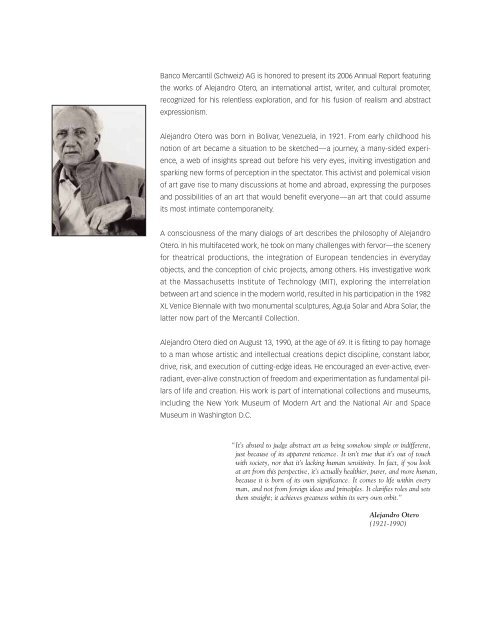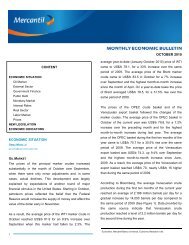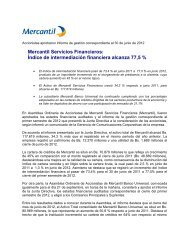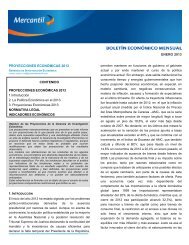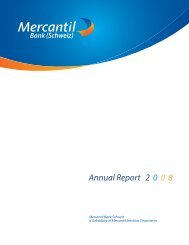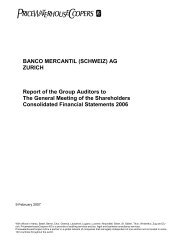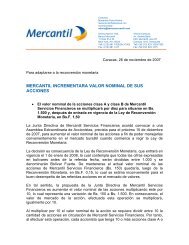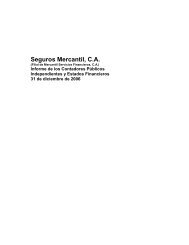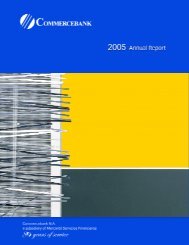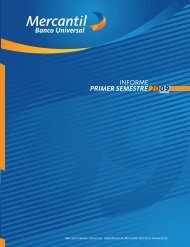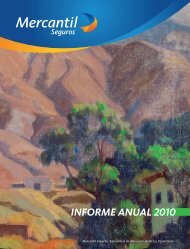Untitled - Banco Mercantil
Untitled - Banco Mercantil
Untitled - Banco Mercantil
Create successful ePaper yourself
Turn your PDF publications into a flip-book with our unique Google optimized e-Paper software.
<strong>Banco</strong> <strong>Mercantil</strong> (Schweiz)AG is honored to present its 2006 Annual Report featuring<br />
the works ofAlejandro Otero, an international artist, writer, and cultural promoter,<br />
recognized for hisrelentless exploration, and for hisfusion of realism and abstract<br />
expressionism.<br />
Alejandro Otero was born in Bolivar, Venezuela, in 1921. From early childhood his<br />
notion of art became a situation to be sketched—a journey, a many-sided experience,<br />
aweb of insights spread out before his very eyes, inviting investigation and<br />
sparking new forms ofperception inthespectator. This activist and polemical vision<br />
of art gave rise to many discussions at home and abroad, expressing the purposes<br />
and possibilities of an art that would benefit everyone—an art that could assume<br />
its most intimate contemporaneity.<br />
A consciousness of themany dialogs of art describes the philosophy of Alejandro<br />
Otero. In his multifacetedwork, he took on many challenges with fervor—the scenery<br />
for theatrical productions, the integration of European tendencies in everyday<br />
objects, and the conception of civic projects, among others. His investigative work<br />
at the Massachusetts Institute ofTechnology (MIT), exploring the interrelation<br />
between art and science in the modern world, resultedinhisparticipationinthe1982 XLVenice Biennale with two monumental sculptures, Aguja Solar and Abra Solar, the<br />
latter now part of the<strong>Mercantil</strong> Collection.<br />
Alejandro Otero died on August 13, 1990, at the age of 69. It is fitting to pay homage<br />
to a man whose artistic and intellectual creations depict discipline, constant labor,<br />
drive, risk, and execution of cutting-edge ideas. He encouraged anever-active, everradiant,ever-alive<br />
construction of freedom and experimentation as fundamental pillars<br />
of life and creation. His work is part of international collections and museums,<br />
including the New York Museum of Modern Art and the National Air and Space<br />
Museum in Washington D.C.<br />
“It’s absurd to judge abstract art as being somehow simple or indifferent,<br />
just because of its apparent reticence. It isn’t true that it’s out of touch<br />
with society, nor that it’s lacking human sensitivity. In fact, if you look<br />
at art from this perspective, it’s actually healthier, purer, and more human,<br />
because it is born of its own significance. It comes to life within every<br />
man, and not from foreign ideas and principles. It clarifies roles and sets<br />
them straight; it achieves greatness within its very own orbit.”<br />
Alejandro Otero<br />
(1921-1990)


